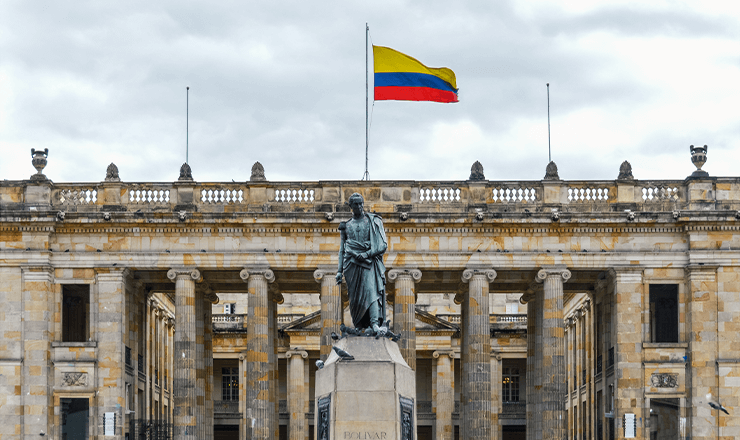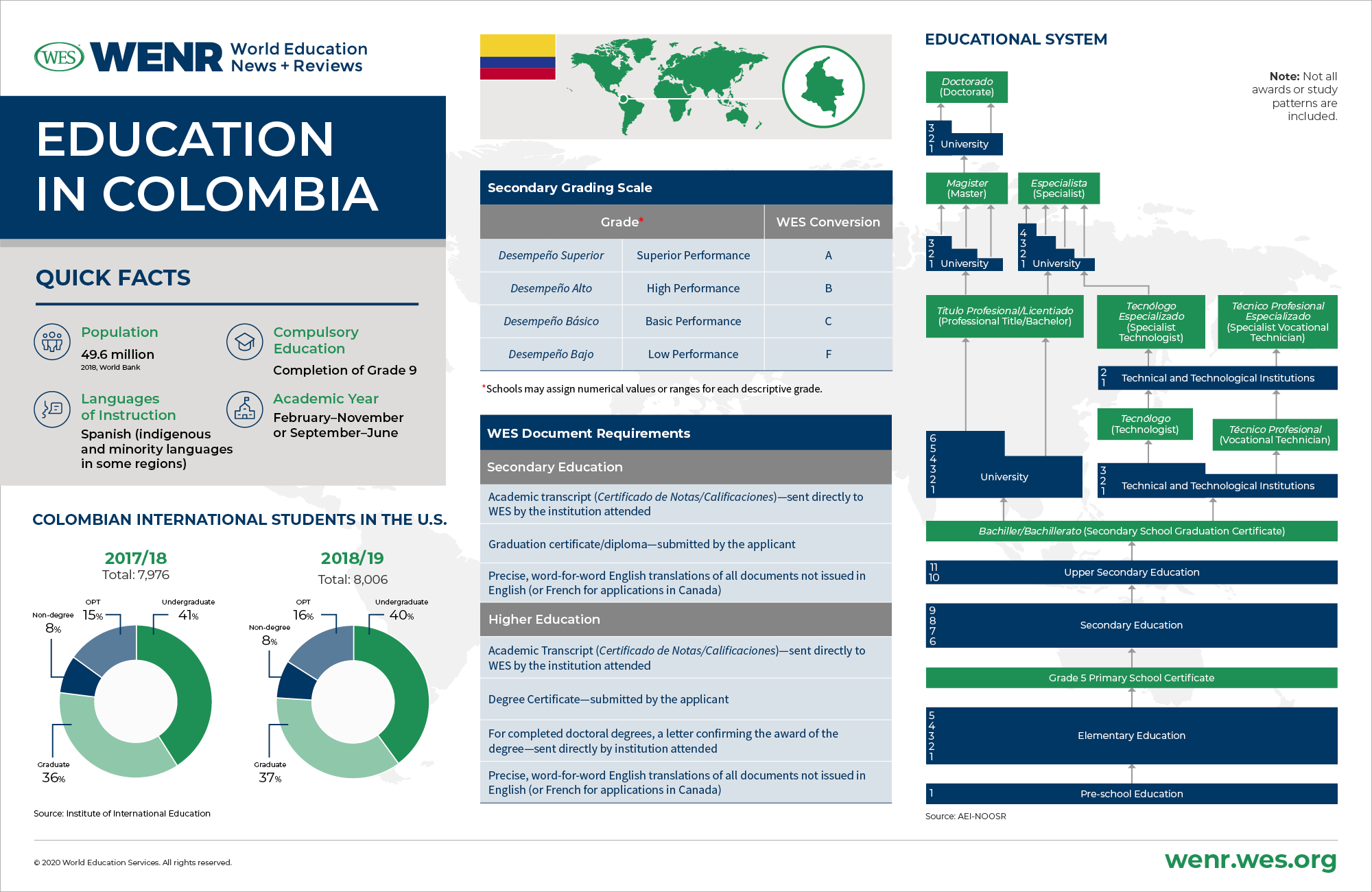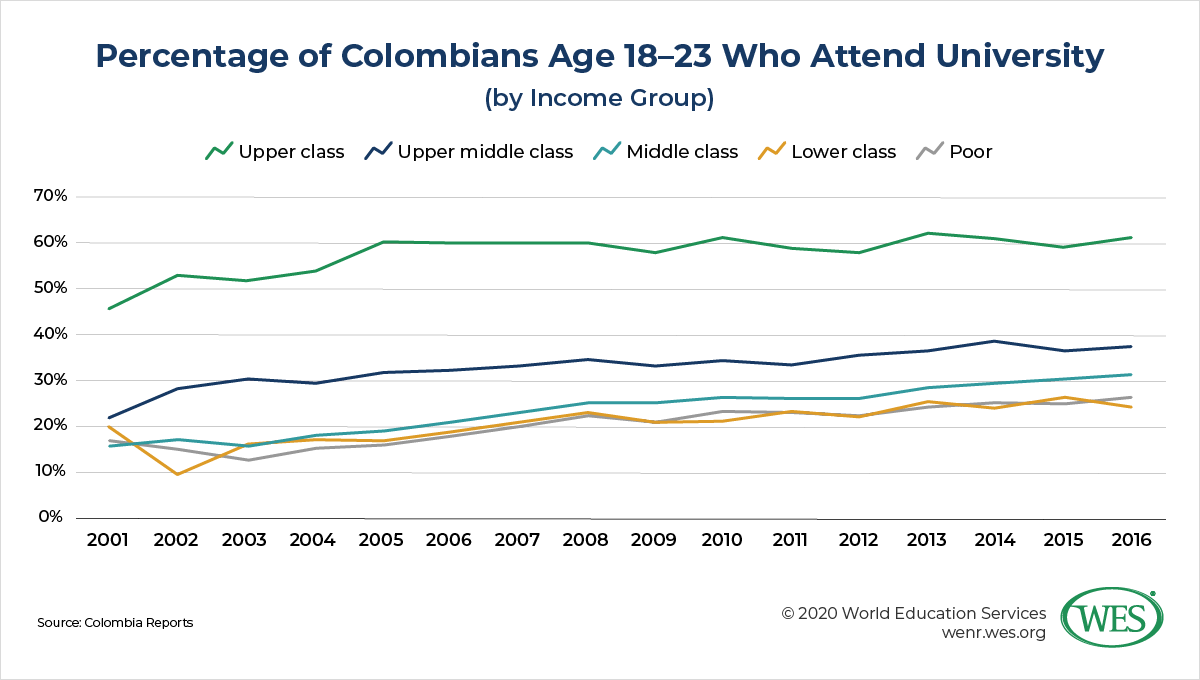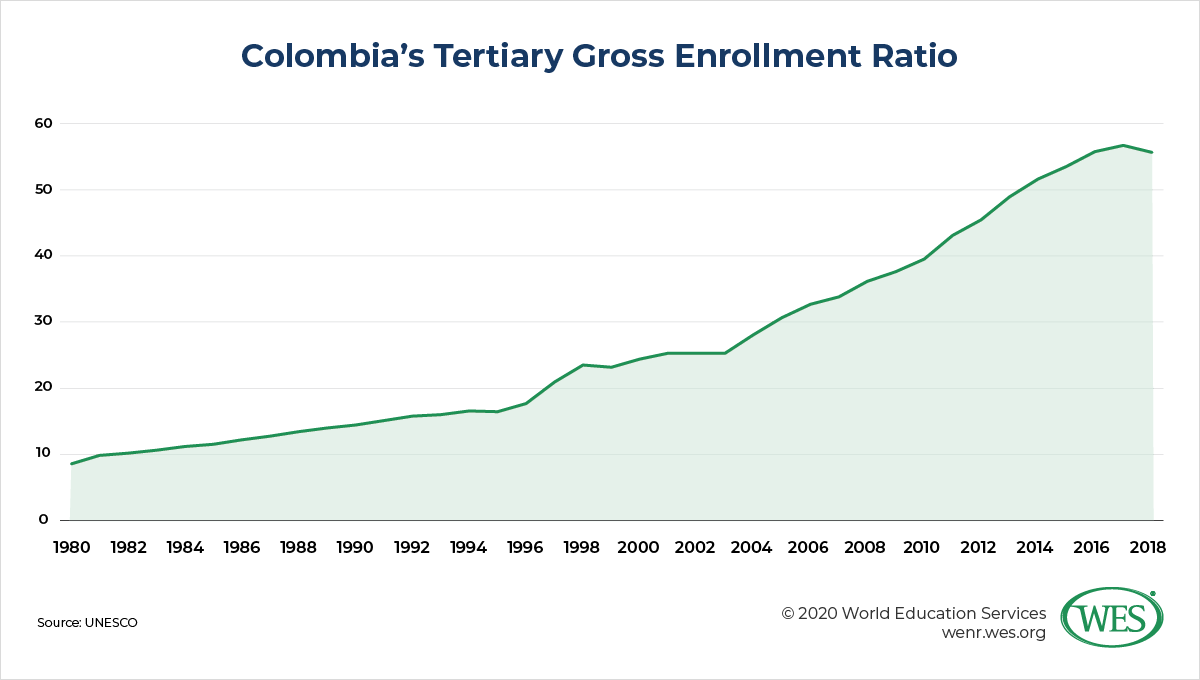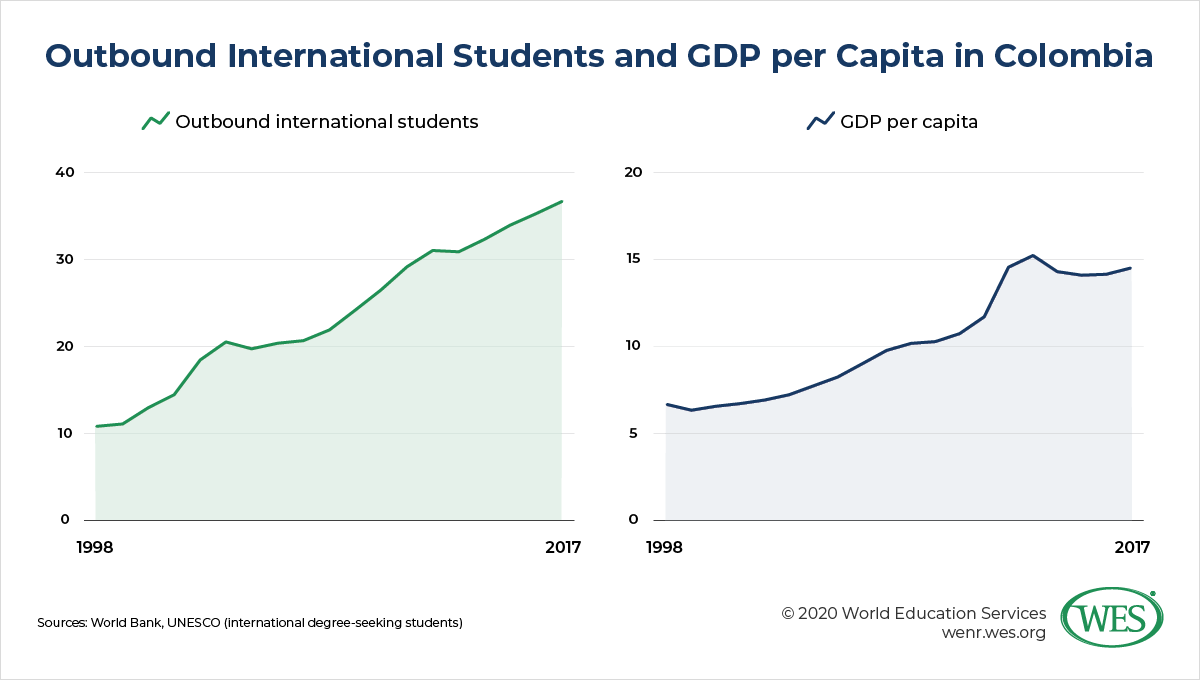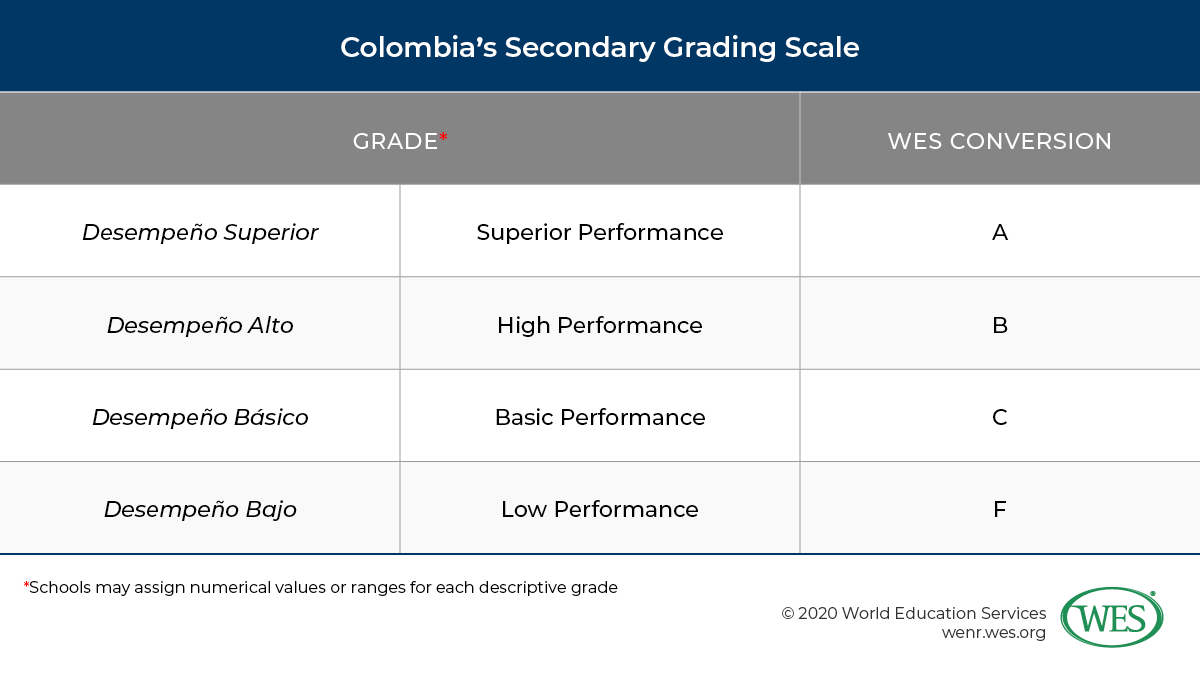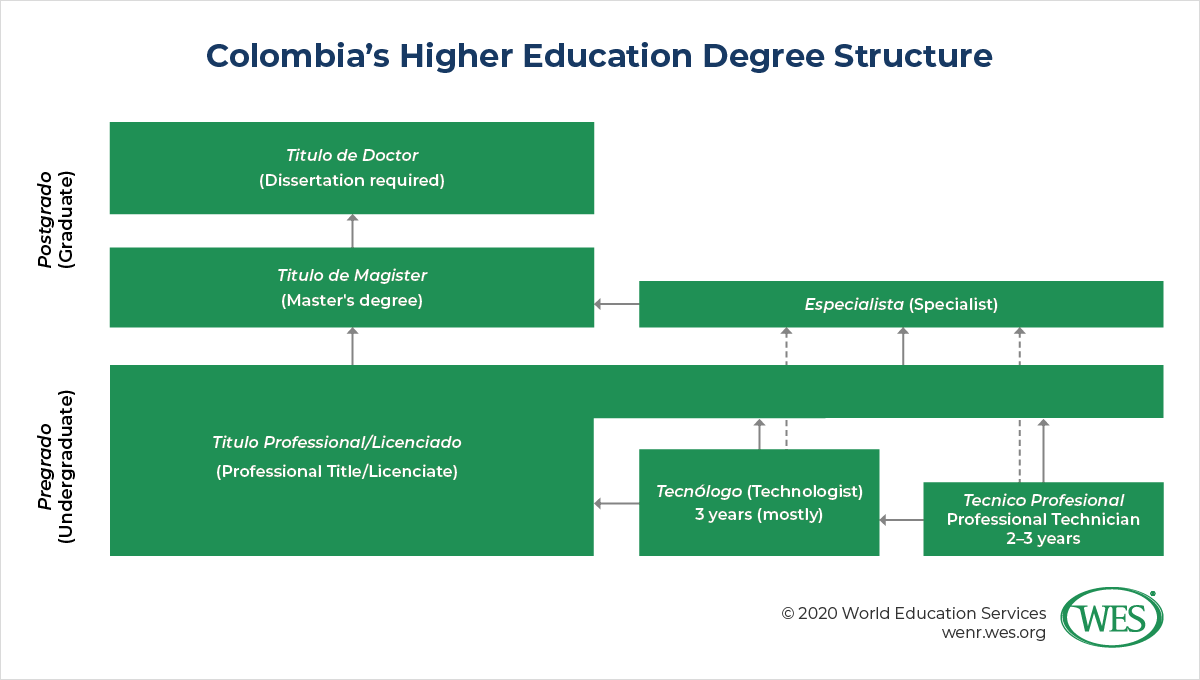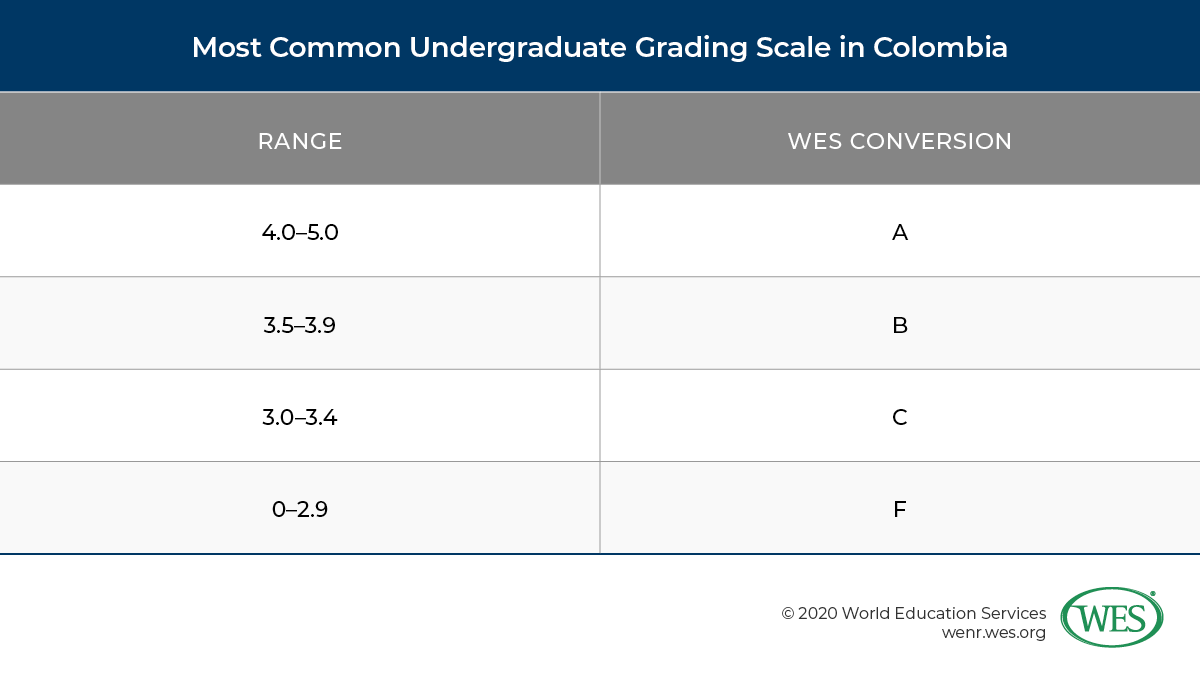Education in Colombia
Leanna Carroll, Knowledge Analyst, WES, Anthony Reyes, Knowledge Analyst, WES, and Stefan Trines, Research Editor, WENR
Like the rest of the world, Colombia was hit hard by the 2020 coronavirus pandemic and had to close its schools. More than nine million elementary and secondary school children were forced to learn from home via educational radio and television broadcasts, or online—in the case of wealthy households that had access to the internet and digital devices. Higher education enrollments were expected to decline significantly because of the loss of income—by as much as 50 percent by some estimates. Economically, social distancing measures and shocks like collapsing prices for crude oil, Colombia’s most important export product, threatened to reverse the country’s recent economic gains.
The crisis hit Colombia, South America’s second most populous country after Brazil, during the “Colombian miracle”—a period of robust economic growth and decreasing poverty rates since the turn of this century. In 2016, a peace agreement between the Colombian government and the Revolutionary Armed Forces of Colombia (FARC) ended the world’s longest civil war and ushered in an era of newfound political stability. After being engulfed in violence and narco-crime for decades, Colombia was experiencing increased prosperity and a boom in tourism.
In education, participation rates had been rising as well—an issue of utmost importance for social mobility in a young society plagued by extreme wealth disparities. Declining birth rates notwithstanding, a quarter of the country’s 49.6 million people is made up of young people between the ages of 15 and 24. Wealth disparities, meanwhile, are such that Colombia is one of the most unequal societies in the world. While considerable progress in leveling inequality had been made over the past decade, the country’s Gini coefficient—a standard measure of wealth distribution—began rising again over the past few years, despite solid economic growth and increasing income levels in general. Poverty, food insecurity, and a lack of access to housing or shelter remain major problems, with women being most affected.
As in many other Latin American countries, there are pronounced disparities in access to education and health services between regions and socioeconomic groups. Social inequalities are omnipresent at all levels of Colombian education. Consider that only 25 percent of the poorest Colombians went to university in 2016, while 61 percent of the richest Colombians did. Lower- and upper-secondary net enrollment rates are 20 percent higher in cities than in remote rural regions.
Given these disparities, it’s good news that access to education is increasing. While Colombia has not yet accomplished its objective of becoming Latin America’s “most educated country”—a goal former president Juan Manuel Santos set out to achieve by 2025—efforts to increase spending and participation in education have paid off as of late. The tertiary gross enrollment ratio (GER), for instance, almost doubled from 28 percent in 2004 to 55 percent in 2018, according to UNESCO. The number of expected years of schooling in Colombia has increased by fully two years since 2007.
At the same time, education in Colombia continues to be held back by various problems, including poor school infrastructure, alarming dropout rates, and a high degree of teacher absenteeism. The OECD PISA study, a standardized test of secondary students in which Colombia has been partaking since 2006, reflects relatively poor learning outcomes in comparison to other nations. In the latest study, from 2018, Colombia ranked second to last among 37 OECD countries, behind Mexico and Chile. Even though the upper-secondary GER has spiked from 58 percent in 2000 to almost 80 percent in 2018, the net enrollment rate (NER) has been mostly stagnant in recent years and stands at only 42.5 percent, reflecting that Colombia has a high number of grade repeaters and overage students.
While Colombia’s overall education spending as a percentage of gross domestic product (GDP) has surpassed spending levels in other upper middle income countries in recent years, funding for higher education is low and fails to keep up with surging enrollments. In 2018, the budget deficit at public universities amounted to USD$5.7 billion between operating and infrastructure expenses.
Higher education spending has been a source of conflict for years with recent neoliberal governments seeking to reduce the role of the state in higher education and to follow the Brazilian model of expanding access via private, for-profit education (currently banned in Colombia). Student organizations, on the other hand, are pushing for greater investment in public education. They warn of a loss of quality if for-profit education is allowed, and view privatization as surrendering the state’s responsibility to provide affordable education to its citizens.
Even though attempts by the Santos administration to allow private, for-profit education in Colombia were thwarted by opposition in the early 2010s, the government in recent years helped boost enrollments at private institutions with a program called Ser Pilo Paga—an initiative that, intentionally or not, funneled more students into private institutions by subsidizing top-performing students with loans and scholarships.
In 2018, the controversial program was eventually suspended when Colombia’s students demonstrated en masse to compel the current right-wing president, Iván Duque Márquez, to increase spending for public higher education. The student demonstrations were followed in 2019 by the largest mass protests in decades. Hundreds of thousands of people from different walks of life took to the streets to demand better health care and pension benefits, less inequality and corruption, and the implementation of the peace agreement with the FARC, several parts of which the Duque government has rejected. It remains to be seen how the political situation in Colombia will evolve in the years ahead. According to opinion polls from June 2019, more than 80 percent of young Colombians between 18 and 24 disapproved of the Colombian president.
Outbound Student Mobility
Before the coronavirus pandemic halted international student mobility worldwide, outbound student flows from Colombia had been growing consistently. In the decade between 2007 and 2017, the total number of Colombian students enrolled in academic degree programs in other countries had doubled, going from 21,808 to 44,423, making Colombia the largest sending country of international students in Latin America after Brazil (per UNESCO statistics). What’s more, Colombia is a booming market for English language training (ELT). Growing numbers of Colombians have headed overseas in recent years to take ELT courses in English-speaking countries like the United States, the United Kingdom, Australia, and Canada.
Colombia’s increasing outbound student mobility reflects the massification of higher education and rising income levels in the country. More and more young Colombians are pursuing higher education, including internationally. The number of tertiary students increased by 140 percent between 2002 and 2018, from about 1 million to 2.4 million. At the same time, greater numbers of households can now afford an expensive international education. While the financial situation of most Colombians remains precarious, the country’s middle class is said to have grown from 11 percent of the population in 2001 to nearly 30 percent in 2014. That said, while observers forecast the number of households in middle income brackets to increase further, notably in big cities, it remains to be seen how the economic fallout of the coronavirus pandemic will affect this trend in the coming years.
Most Colombian students pursuing degree programs abroad—about one quarter—are enrolled in Argentina, followed by the U.S. (17 percent), Spain (12 percent), Australia (8.5 percent), and France (7 percent). Geographic proximity and a shared language make Argentina a logical choice for Colombian students. Compared with more expensive Latin American destinations like Chile, Argentina also offers high-quality education at a low cost—it has “a well-established public higher education system with few fees (if any), no admissions exams and a globally respected level of quality. As such, it is … a strong choice … for students regionally.”
The U.S. is not only a desirable immigration destination for Colombians—280,000 Colombian citizens were granted permanent residency in the U.S. between 2002 and 2012 alone—but also an increasingly popular study destination. While there have been some fluctuations in volume in previous years, the number of Colombian international students in the U.S. has increased by 23 percent since 2012/13, and stood at 8,060 in the 2018/19 academic year, according to the Open Doors data of the Institute of International Education. This means that Colombia is currently the 21st-largest sending country of international students to the United States.
A plurality of Colombian students in the U.S.—40 percent—study at the undergraduate level, while 37 percent are enrolled in graduate programs, 8 percent in non-degree programs, and 16 percent pursue Optional Practical Training. At the graduate level, mobility is facilitated by scholarship programs for master’s and doctoral studies run by the Colombian government, such as Colfuturo. The largest share of the beneficiaries of these programs are studying in the United States.
A high number of Colombians in the U.S. study at the doctoral level relative to students of other nationalities. In 2018, Colombians were the 11th-largest group of foreign nationals holding student visas for doctoral programs. One factor that drives these students to the U.S. is the small number of available doctoral programs in Colombia. According to the Migration Policy Institute, these students tend to be less interested than other international students in remaining in the U.S. long term, at least in previous years. “About 70 percent of international students who were awarded a PhD in the United States during 2012 planned to stay in the country after graduating, but only 53 percent of the Colombian students shared that aspiration.”
Scholarship funding and transnational academic cooperation have also led to an increase in graduate student inflows to European Union countries, such as Spain, France, the U.K., and Germany. France, for instance, has a long tradition of promoting student exchange with Colombia, including a bilateral agreement on the mutual recognition of academic qualifications, as well as various inter-university agreements and research collaborations.
Australia is another country that has grown rapidly in popularity among mobile Colombian students over the past decade. According to Australian government statistics, the number of enrollments by Colombian students nearly tripled between 2010 and 2020, from 6,627 to 18,229, making Colombia the seventh-largest sender of international students. It should be noted, however, that only a small fraction of these students is enrolled in tertiary education programs. Most Colombians are enrolled in vocational training or ELT programs (ELICOS), reflecting the growing demand for ELT in Colombia and Latin America in general.
Like Australia, Canada witnessed a surge in Colombian student enrollments in recent years, if on a smaller scale. Per government statistics, the number of Colombian students in the country grew by 278 percent between 2014 and 2019, from 1,485 to 5,620—a number that comprises both tertiary students and a sizable number of ELT students. Until recently, analysts projected further growth in Colombian enrollments because of factors like Canada’s comparative cost advantage over the United States. As with other study destinations, it remains to be seen, however, to what extent student flows to Canada will rebound after the COVID-19 crisis.
Inbound Student Mobility
The number of international students in Colombia is minor—fewer than 5,000 students from other countries were enrolled in degree programs at Colombian higher education institutions (HEIs) in 2018, according to UNESCO. Except for a small number of European, notably French, and U.S. students, most international students came from other Latin American countries with Venezuela (1,631 students), Ecuador (566), Mexico (441), and Peru (335) being the top senders. Given the political stability in Colombia, there’s now also a growing number of U.S. students visiting on short-term study abroad programs, but that number still pales in comparison to other Latin American countries like Mexico, Ecuador, or Argentina.
It’s unsurprising that large numbers of students from Venezuela seek refuge in neighboring Colombia, considering Venezuela’s political crisis and economic collapse. There’s a massive brain drain of students and professionals amid rampant food insecurity, crime, unemployment, lack of education funding, on-campus violence, and the closure of academic institutions. According to UNESCO, there were some 4.5 million refugees and migrants from Venezuela worldwide in 2020, about a third of them in Colombia. That same year, close to 200,000 Venezuelans under the age of 18 were enrolled in Colombian schools.
However, providing access to education to most Venezuelans in Colombia is a major challenge. Fully 260,000 children of Venezuelan migrants were out of school before the COVID-19 crisis. Now matters are even worse. Participation in tertiary education among Venezuelan migrants is minuscule and hampered by inflexible admission requirements and a lack of funds to pursue education. While many Venezuelan refugees are educated professionals, they may not have access to adequate academic documents to support their applications to universities. Many have difficulties obtaining work permits, they are often discriminated against in the Colombian labor market, and they often end up working low-skilled jobs.
In Brief: The Education System of Colombia
Modern education in Colombia was introduced by the Catholic church during the era of Spanish colonialism. The first schools were set up in the 16th century to educate the children of the colonizers. This was followed by the establishment of Catholic seminaries and a few universities, including Saint Thomas University, Colombia’s oldest university, which opened in Bogotá in 1580. Until independence in the early 19th century, the education system remained rigidly elitist.
After independence, the administration of the education system was increasingly taken over by the Colombian state, although the Catholic church continued to strongly influence education intermittently under different governments well into the 20th century. In 1870, elementary education was made free and compulsory in public schools. However, efforts to increase participation were initially held back by the church, which opposed public education, and glacial progress in rural regions. As recently as 1970, “about 70 percent of rural school age children did not attend school. Nearly 77 percent of the rural schools had one classroom, and 80 percent of the rural schools had one teacher. Few students attended school for very long.… Facilities were poor—21 percent of the students lacked desks.”
Secondary education, even more so, was mostly a privilege of urban households and did not become widespread nationally until the end of the last century, when the secondary GER jumped from 43 percent in 1981 to 74 percent in 1999—one of the fastest growth rates in Latin America.
As the number of secondary school students increased, the higher education system grew as well. The tertiary GER rose from a mere 5 percent in 1972 to 23 percent at the end of the century. At the same time, the system became increasingly diversified with a growing number of smaller demand-absorbing private institutions supplementing state universities, private Catholic universities, and other types of HEIs. More short-term programs in popular fields like business administration popped up alongside traditional degree programs in professional disciplines. Within just one decade, between 2001 and 2011, the number of higher education programs in Colombia surged, going from 3,600 to 6,276.
As a result of this swift massification, Colombia developed a heterogeneous higher education system marked by significant disparities in quality between selective top institutions and bottom-tier “garage universities.” Another issue was that, despite these trade-offs in quality, bottlenecks remained in access to higher education. According to the OECD, the absorption rate of Colombian HEIs—defined as the total number of students admitted over the total number of students that apply—stood at only 55 percent in 2011. Despite a fast-growing tertiary GER, there are still many aspiring Colombians who remain locked out of the country’s higher education system.
Administration of the Education System
Colombia is a decentralized but unitary state divided into 32 departments, which are further subdivided into 1,123 municipalities. The cities Bogotá, Barranquilla, Buenaventura, Cartagena and Santa Marta have special administrative status.
The Ministerio de Educación Nacional (MEN) in Bogotá sets overall education policy and school curricula, and monitors education quality. At the local level, administrative responsibilities are determined by a process of certification. All 32 departments and all municipalities of at least 100,000 inhabitants, as well as some smaller municipalities “judged to have sufficient technical, financial and administrative capacity” have been designated as “Certified Territorial Entities” (CTEs). These CTEs implement education policies and oversee public and private schools within their jurisdictions, including the autonomous management of funding and teaching staff. Non-certified municipalities, on the other hand, have less autonomy; they fall mostly under the purview of the departments.
In contrast to the decentralized school system, higher education in Colombia is centrally steered by the MEN, which licenses all HEIs, public or private, and provides quality assurance with the assistance of institutions like the Consejo Nacional de Acreditación (CNA) or the Comisión Nacional de Aseguramiento de la Calidad de la Educación Superior (CONACES). While universities generally have a relatively high degree of autonomy, all degree programs must meet certain minimum requirements and be registered and authorized by the MEN (for more information, see the section on quality assurance below).
Academic Calendar
The academic year in Colombia consists of 40 weeks of study over two semesters divided by a 12-week break. For the school system, the MEN has set forth minimum teaching hours per year: 800 hours at the preschool level, 1,000 in elementary education, and 1,200 in secondary education. Within these parameters, departments can choose between two different semester systems: option A, an academic year that runs from February to November; or option B, an academic year that begins in September and ends in June. While some departments elected for option B in the past, all of them are currently using the first option, according to the MEN. However, there may be some variations at the local level. It should also be noted that private institutions are free to use different semester systems as long as they teach the required minimum hours per year.
Language of Instruction
While Colombia is a multicultural society of more than 87 ethnic groups and 64 spoken indigenous languages, Spanish is the official language and predominant language of instruction. However, in some regions, indigenous and other languages are used as the medium of instruction alongside Spanish. A new native language law, adopted in 2010, strengthened etnoeducación and bilingualism.
There has also been a great emphasis on promoting English proficiency in recent years—a policy explicitly driven by the objective to enhance Colombia’s competitiveness in the global economy. The “National Bilingual Program 2004-2019” marked a major milestone in that it made English a mandatory subject of upper-secondary school curricula while specifying set English proficiency levels that high school and university students should reach upon graduation. To benchmark proficiency levels, Colombia relied on the Common European Framework of Reference for Languages (CEFR) and worked with Cambridge Assessment to develop its English language tests. However, despite significant progress, proficiency levels have recently fallen short of official targets, and Colombia keeps trailing other South American countries like Argentina, Uruguay, Chile, Paraguay, Bolivia, and Peru in rankings of its command of English. At universities, nearly all programs are taught in Spanish.
Elementary Education
School education in Colombia comprises a compulsory basic education cycle (educación básica, grades 1 to 9), followed by two years of non-compulsory secondary education (grades 10 and 11). Prior to elementary school, children may enroll in early childhood education (educación preescolar), which is offered in three stages: pre-kindergarten (pre-jardín, age three), kindergarten (jardín, age four), and a transitional year (transición, age five). However, while Colombia has made tremendous progress in boosting preschool enrollment levels, only the transitional year is compulsory, and few children participate in formal early childhood education, although they may attend informal home- or community-based child care programs.
Elementary education (educación básica primaria) is the first stage of basic education and is provided free of charge at public schools. It begins at age six and lasts five years (grades 1 to 5). There are various types of schools providing this type of education. Some schools offer only elementary education while others also provide preschool or secondary education. Other institutions serve students in disadvantaged rural regions with non-traditional curricula and educational television. Large numbers of rural schools use the “new school” model (escuela nueva)—an innovative form of multi-grade schooling with flexible curricula and self-paced learning.
Most schools are public—only 20 percent of elementary school students were enrolled in private schools in 2018. Private institutions are almost exclusively located in the cities and tend to cater to wealthier households, although there are some low-fee private schools for disadvantaged students. Generally, private schools are better equipped and staffed, and lead to better learning outcomes than the often poorly funded public schools. In addition, there are schools that operate under public-private partnership agreements. These are mostly privately run and subsidized by the state.
Whether public or private, schools in Colombia must follow mandatory curricular guidelines issued by the MEN that define core learning subjects (áreas obligatorias y fundamentals). The national curriculum for both elementary and lower secondary education (basic education) includes Spanish, foreign language, mathematics, natural sciences, social sciences, arts, ethics, religion, arts, and technology and computing. Schools have some leeway to decide how many learning hours they allocate to specific subjects as long as 80 percent of total learning time is devoted to the obligatory subjects. The MEN provides more detailed guidelines on individual subjects on its website.
Aside from the mandatory curricular guidelines, Colombian schools have a high degree of autonomy in matters like student assessment. This means that promotion requirements and assessment practices may vary by institution. Of note, promotion from one grade to the next is exclusively based on internal school assessment—there are no external examinations in basic education. Pupils sit for a standardized test conducted by the Instituto Colombiano para el Fomento de la Educacion Superior (ICFES) in certain core subjects at the end of grades 5 and 9. However, unlike in upper-secondary education, where the test can determine a student’s future academic prospects, at these grades test results are used only for the evaluation of the schools and don’t affect whether students get promoted.
Lower-Secondary Education
The second phase of basic education, educación básica secundaria, comprises grades 6 to 9. Admission requires the completion of elementary education; there are usually no entrance exams or other additional requirements. Pupils study the same obligatory subjects as before, but the total number of contact hours increases from 25 to 30 per week. Upon completion of the program, graduates may receive a Certificado de Estudios del Bachillerato Básico (certificate of basic secondary school education) or some variation thereof.
Schools providing lower and upper-secondary education have different names. They may be called colegios, gimnasios, institutos, or liceos. As in elementary education, most schools are public. Some 18 percent of lower-secondary students were enrolled in private schools in 2018. That percentage rises to 26 percent in upper-secondary education.
Upper-Secondary Education
Progression to upper-secondary education (educación media, grades 10 and 11) generally requires the completion of basic education, although some schools may impose additional admission requirements. Upper-secondary education is not compulsory, but there are plans to make it so by 2030 and also to add a 12th year of schooling to align Colombia’s system with the vast majority of education systems worldwide.
Compared with basic education, educación media is more diversified and comprises different streams. There’s a general academic stream (bachillerato académico), as well as an employment-geared technical stream (bachillerato técnico). Both programs include general academic core courses, but the academic program focuses on further specialization in subjects like natural sciences, social sciences, humanities, or foreign languages, whereas the technical program features theoretical and practical courses in specific vocations, such as commerce, agriculture, information technology, or industry. Graduates of both programs are eligible to be admitted to tertiary education. Most students enroll in the academic track, while only a minority pursue studies in the technical stream.
Unlike in basic education, there’s no set national upper-secondary curriculum. The MEN has issued curricular guidelines for several core subjects, but the guidelines are not binding, so there can be significant differences in curricula from school to school. However, all high school graduates who wish to pursue higher education must take the national ICFES exam at the end of grade 11 (see sidebar below)—a fact that helps to harmonize curricula.
Graduates receive a diploma and title that denote the type of program, that is, either the Título de Bachiller Académico (title of academic bachelor) or the Título de Bachiller Técnico (title of technical bachelor). Schools set their own graduation requirements—the MEN does not impose regulations—but most institutions require a minimum grade average that is determined by internal examinations and other criteria. The MEN has set forth a national grading scale, but schools are free to use their own “institutional student assessment systems” as long as they also convert their grades to the national scale (shown below). This means that academic transcripts from schools that use alternative scales, numerical or otherwise, typically list both the institutional grade and the converted national grade on their academic records.
There’s a growing number of international schools and colegios bilingues in Colombia that cater to the children of wealthier households. In many cases, students at these schools earn both a Colombian bachillerato diploma and a foreign qualification, such as a U.S. high school diploma.
Saber 11 (ICFES Exam)
The Saber (knowledge), previously known as the ICFES exam, is a standardized test that assesses the knowledge and skill of Colombia’s students. The Saber is given in different grades (3, 5, 9, 11) and used to measure the performance of schools and the overall quality of the education system. While it does not impact the academic progression of students, the Saber 11 is of utmost importance to high school graduates, since Colombian HEIs require it for admission. It’s also relevant for obtaining scholarships and student loans.
The Saber 11 test covers five subjects: critical reading, English, mathematics, natural sciences, and social science and civics. The exam is given twice a year to accommodate different academic calendars (options A and B). It consists of multiple-choice questions and a few essay questions, administered over two sessions of four and a half hours. The overall maximum score is 500, with 0-100 possible points in each subject. Except for the English section, which is ranked in accordance with the European CEFR standards, the final scores are grouped into four categories, the last of which is considered insufficient. In the final exam session of 2018, 17 percent of test takers fell into that category. Students from private schools and urban areas tend to perform better on the exam than students from public schools and rural regions. Students are free to retake the exams to improve their scores.
Challenges: Low Participation and High Dropout Rates
Even though educación media was made tuition-free at public schools in 2012 and attendance rates have been rising steadily in recent years, participation remains low by international standards. The upper-secondary net enrollment ratio—the percentage of enrollments within the relevant age group—stood at only 42.5 percent in 2018.
Grade repetition rates, likewise, are high, resulting in large numbers of overage schoolchildren in Colombia. According to the OECD, the number of 15-year-olds who had repeated at least one grade increased from 38 percent to 43 percent between 2009 and 2015—the second-highest percentage among 70 countries participating in the 2015 PISA study. What’s more, large numbers of students drop out of school, especially in rural regions, where less than half of all upper-secondary students persisted until grade 11 in the mid-2010s.
Given the high number of dropouts and individuals who don’t enter upper-secondary education at all, ICFES offers older Colombians the opportunity to earn a bachillerato diploma by sitting for an equivalency exam that closely resembles the Saber 11 (examen de validación del bachillerato académico). Individuals can prepare for the exam in adult education schools, continuing education programs, or the flexible “tutorial learning system.”
Technical and Vocational Education (TVET)
In addition to upper-secondary bachillerato técnico programs, non-tertiary TVET in Colombia is provided in the form of applied practical training programs in fields like agriculture, automotive technology, business, electronic technology, nursing, or allied health. The main TVET provider and quality assurance body in the sector is the public Servicio Nacional de Aprendizaje (SENA), which is part of the Ministry of Labor. However, several private institutions run vocational training programs as well.
While there are variations, most programs require the completion of basic education (grade 9) for admission, and last between one and a half and three years (600 to 1,800 hours). At least half of the program is devoted to practical training, typically an apprenticeship at a workplace, supplemented by theoretical study at a training center or other type of school. Depending on the program and field of training, the final qualification may be called certificado de aptitud ocupacional (certificate of occupational qualification, CAO), certificado de aptitud profesional (certificate of professional aptitude, CAP) or a certificate of técnico laboral (labor technician). Given that SENA also offers technical secondary programs, some students may concurrently earn a bachillerato técnico and a CAP certificate or similar.
Higher Education (Educación Superior)
Colombia’s higher education system has evolved and expanded dramatically since the last century. The number of tertiary graduates, for instance, went from only 65,720 in 2002 to 482,122 in 2018. The social impact of this growth has been highly positive. Colombians who hold tertiary degrees are employed at higher rates and earn twice as much as those with an upper-secondary education.
However, there’s been a noticeable decrease in higher education enrollments in recent years, especially at private institutions, where enrollments decreased by more than 10 percent between 2016 and 2018. Declining fertility has curtailed population growth, so that the total number of university-age Colombians is slowly shrinking.
What’s more, the recent suspension of the Ser Pilo Paga scholarship program, which is said to have aided 32 percent of new students at accredited universities, predominantly private ones, has lowered enrollments. While tuition fees at public institutions are flexible and tied to income, the high cost of tertiary education in Colombia remains a barrier to many. Consider that undergraduate tuition fees at top private universities like the Universidad de los Andes can exceed USD$13,000 per year. Overall, Colombia still has one of the lowest percentages of tertiary-educated adults in the OECD, with low postgraduate attainment in particular.
Types of Higher Education Institutions
HEIs in Colombia are categorized into four different types, based on the programs they offer:
Universities (Universidades)
Universities are institutions entitled to offer the full range of academic programs, from the bachelor’s to the doctoral level. In 2018, there were 86 of these institutions. They are generally large multi-faculty research universities, although some institutions, such as pedagogical universities, are more specialized than others. The largest, the National University of Colombia, offers more than 400 programs and in 2018 enrolled 53,758 students.
Almost two-thirds of universities (53) are private, but some private institutions are small, so that total enrollments are more evenly split between private and public institutions. Private universities include several faith-based institutions, including Catholic universities like the Universidad de Santo Tomás or the Universidad Pontificia, or the Seventh-day Adventist Corporación Universitaria Adventista. Many universities have branch campuses in multiple locations.
University Institutions and Technological Schools (Instituciones Universitarias o Escuelas Tecnológicas)
University institutions and technological schools form a group of more specialized HEIs that provide education in professional disciplines. While they may offer postgraduate specialization programs, they are not allowed to offer master’s or doctoral programs. The overwhelming majority of these institutions—103 out of 134—were private in 2018. Technological schools generally specialize in technical fields like engineering or architecture, while university institutions can offer a broader range of programs, including programs in the arts.
Technological Institutes (Instituciones Tecnológicas)
Technological institutes are post-secondary institutions that offer applied academic programs below the bachelor’s degree level. Some of these programs articulate with higher programs at university-level institutions and allow graduates to progress to tertiary education. In 2018, there were 48 technological institutes, 37 of them private.
Technical Training Institutes (Instituciones Técnicas Profesionales)
Technical training institutes represent the most vocationally oriented type of HEI in Colombia. These institutions offer mostly short-term training programs (tecnico profisional) with an applied focus, often including internships. In 2018, there were 30 technical training institutes, two thirds of them private.
Colombian Universities in International Rankings
While Brazil, Chile, and Mexico have more universities among the top 100 in the most common Latin America university rankings, several of Colombia’s HEIs feature prominently in these rankings. There are 10 Colombian universities in the most recent Times Higher Education 2019 Latin America rankings compared with 37 Brazilian, 20 Chilean, 13 Mexican, and seven Argentinian institutions. The top-rated Colombian institution in the Times’ global 2020 ranking is the Pontificia Javeriana University, a private university established in the 17th century by Jesuits, ranked within the 401-500 range. The other Colombian HEI among the top 1,000 is the Universidad de los Andes, ranked 601-801.
There are 12 Colombian universities among the top 1,000 in the QS 2020 global ranking, compared with 19 Brazilian, 13 Argentinian, 13 Mexican, and 11 Chilean, institutions. The top-rated institutions are the Universidad de los Andes (234), the Universidad Nacional de Colombia (253), and the Pontificia Universidad Javeriana (468). Most top-rated institutions are private.
Quality Assurance and Accreditation
Before they can begin to enroll students, all new HEIs in Colombia, public or private, must obtain a license from the MEN and comply with certain minimum requirements in terms of infrastructure and financial resources. In addition, all degree programs must be evaluated and obtain a registro calificado (qualified register) based on the recommendation of the Comisión Nacional Intersectorial de Aseguramiento de la Calidad de la Educación Superior (CONACES). Programs that fail to obtain sufficient registration cannot be offered. Programs are usually certified for seven years, after which they are re-evaluated.
In addition to the mandatory certification, there’s a more rigorous voluntary accreditation process for both academic programs and institutions under the purview of the Consejo Nacional de Acreditación (CAN). Accreditation is based on the evaluation of self-assessments, peer review, and on-site inspections. The CAN takes into consideration criteria like mission statements, admissions requirements, faculty qualifications, student assessment systems, internal quality assurance mechanisms, infrastructure, funding, and an institution’s commitment to research. Depending on the type and quality of the program or institution, accreditation is granted from anywhere between four and 10 years, after which a re-evaluation by CAN is necessary. HEIs with institutional accreditation do not need to apply for a registro calificado when establishing new programs.
Information on the approval and accreditation status of programs and institutions is provided by the Sistema Nacional de Informacion de la Educación Superior (SNIES). Institutional accreditation is still somewhat uncommon in Colombia. Only 52 out of 269 HEIs currently listed in the SNIES registry are accredited, about 80 percent of them universities. The same holds true for programs—only 1,722 of 13,519 active programs listed by SNIES in June 2020, or about 13 percent, were accredited. Though they are relatively few, accredited programs are sought after—44 percent of higher education enrollments in 2018 were in accredited programs, according to SNIES. It should also be noted that since accreditation is voluntary, the lack of it does not necessarily indicate poor institutional or program quality.
Saber Pro and Saber TyT
Like the Saber exams in the school system, there are tests to measure the quality of tertiary education. The Saber Pro exam is given annually to undergraduate students in the final year of their academic programs. It assesses general competencies in critical reading, quantitative reasoning, English, writing, and citizenship competencies, as well as competencies related to specific majors. While taking the test is mandatory for graduation, the test scores don’t usually affect a student’s ability to graduate. However, ICFES publishes the test results, making the Saber important for institutional rankings and reputation.
A similar test called Saber TyT is given to students in Técnico Professional and Tecnólogo (TyT) programs. This test assesses the same general competencies as the Saber Pro, but the subject-specific assessments are tailored to the more applied and employment-geared nature of TyT programs. Depending on the program, the Saber TYT may include assessment modules in fields like computer maintenance or the operation and maintenance of machinery.
University Admissions
Admission into higher education programs is generally based on the upper-secondary bachillerato diploma and Saber 11 test scores. However, beyond these criteria, HEIs are autonomous in their admissions decisions, so that the minimum required Saber score varies by institution. Several HEIs, especially prestigious universities and in-demand programs, also administer their own entrance exams and conduct interviews in addition to reviewing the Saber. Technological institutes and technical training institutes, on the other hand, may be entered on the basis of the completion of basic education and a TVET qualification like the CAP or CAO in combination with relevant work experience.
The Higher Education Degree Structure
Higher education in Colombia is categorized into two levels: undergraduate (pregrado) and graduate (posgrado). The undergraduate level comprises applied technical credentials (Técnico Professional and Tecnólogo) and the academic Título Profesional awarded by universities. The postgraduate level comprises specialization programs (Especialista), and master’s and doctoral degrees (Magister and Doctorado). In 2018, most students—64 percent—were enrolled in undergraduate university programs, while 29 percent attended technical programs, and 7 percent studied at the graduate level. Non-degree specialization programs are most popular at the graduate level—only a small minority of students pursued master’s (2.8 percent) or doctoral degrees (0.25 percent).
Credit System and Grading Scale
The Colombian government has set forth an academic credit system that defines one credit unit as 48 notional learning hours, divided into 16 hours of class attendance and 32 hours of independent preparatory work outside the classroom. While this system is generally similar to the U.S. system, there are considerable variations between Colombian institutions in terms of credit requirements, so that a year of study at the undergraduate level may correspond to anywhere between 30 and 45 credit units. For some programs, the official length is expressed only in credits, not semesters.
The most common grading scale is 0-5 with 3 being the minimum passing grade at the undergraduate level. (Note that 2 is the minimum passing grade at the graduate level.)
Técnico Professional
The Técnico Profesional (professional technican) qualification is usually earned at technical training institutions. Programs in this category are applied and geared toward employment. They provide vocational training for a specific occupation. Programs usually last two, two and a half, or three years. Graduates obtain a formal academic title in a specific discipline, such as, for example, the Técnico Profesional en Diseño Textil (professional technician in textile design). Depending on the field of study, they may in some instances pursue further specialization studies, leading to the Técnico Profesional Especialista (specialized professional technician) after up to two years of additional study. However, the more common academic pathway chosen by these graduates is progression to Tecnólogo or Título Profesional programs.
Tecnólogo
While also applied and vocational in nature, the Tecnólogo (technologist) is a more academic qualification than the Técnico Profesional and may also be awarded by universities and university-level institutions. It prepares students for mid-level technician and managerial positions in fields like business administration, engineering, or information technology. Programs are typically three years in length. Graduates from Técnico Profesional programs in related fields may be able to get exemptions and complete a Tecnólogo program in less than two years. Further specialization in specific fields is possible after completing a Tecnologo Especializado (specialized technologist) program.
Título Profesional
Tertiary undergraduate programs offered by universities and university-level institutions are four or five years in length, except in the case of programs in professional fields like medicine, which last six years or longer. In most cases, curricula include a combination of general education subjects and specialization subjects, as well as a final project, thesis, or practicum. Courses in a foreign language, typically English, are required. The final credential is generically called Título Profesional (professional title), but commonly denotes as well an academic title in a specific field, such as Título de Químico/a (title of chemist) or Título de Contador/a Public (title of public accountant). Depending on the program and institution, holders of a Tecnólogo qualification may be granted exemptions and be able to complete an accelerated program.
Título de Especialista
University graduates may enroll in specialization programs to pursue further studies in their major. These programs last between one and two years. A degree in a relevant field is required for admission, as are entrance examinations in some cases. The final credential is called the Titulo de Especialista (title of specialist). Unlike master’s programs, specialization programs do not require a thesis and do not provide access to doctoral programs.
Título de Magister
Magister (master) programs are academic research programs offered exclusively by universities. Admission is based on a first university degree (Título profesional) and other requirements like entrance examinations and English language skills, depending on the institution. Most programs are between one and a half and two years in length. Curricula involve coursework and the preparation of a thesis or research project in the final stage of the program.
Título de Doctor
The Doctorado (doctorate) is a research degree offered by select universities; it represents the highest qualification in the Colombian system. Programs are three or four years in length and generally require a master’s degree for admission in addition to other requirements like entrance examinations and English language skills, depending on the institution. Curricula include coursework concentrated in the early stages of the program followed by the preparation and defense of a dissertation. In some instances, universities may admit students based on an undergraduate degree, in which case the programs are longer.
Medical Education
Entry-to-practice degrees in disciplines like medicine, dentistry, or veterinary medicine are earned upon the completion of long undergraduate programs. Programs in dentistry and veterinary medicine last five years and conclude with the award of the Título de Odontologo (title of dentist) and Título de Medico Veterinario (title of veterinary doctor), respectively.
Programs in human medicine, on the other hand, are six or seven years in length. They are currently offered by more than 60 HEIs, most of them private universities. Curricula usually include pre-medical general science courses in the first two years, before clinical studies are introduced in the third year. Programs then conclude with a year of practical clinical rotations. The final credential is called Título de Doctor en Medicina y Cirugía (Title of Doctor of Medicine and Surgery) or Título de Medico y Cirugía.
To practice, graduates must also complete a one-year mandatory social service (servicio social obligatorio), which typically involves an in-service internship at a hospital, and obtain a license from the Ministry of Health. Further specialization in a medical field requires another one to four years of clinical training, depending on the specialty. Graduates are awarded the Título de Especialista en Medicina (title of medical specialist).
Teacher Education
The academic qualifications required to teach in Colombian schools is determined by the teaching level. Elementary and preschool teachers can complete a teacher training program at dedicated teacher training schools (escuelas normales superiors), whereas secondary school teachers must have an undergraduate degree from a university-level institution. That said, Colombia is attempting to upgrade the qualifications profile of its teachers. Elementary teachers in some departments must now have a university-level degree as well. The trend is generally towards higher level training – only 6 percent of Colombia’s current teacher work force has been educated at teacher training schools; 69 percent of these teachers work in rural areas.
Programs at teacher training schools are offered in two forms: two-year post-secondary programs entered on the basis of the bachillerato, and programs that straddle upper-secondary and post-secondary education. Students in the latter track enter after they complete basic education (grade 9) and study the same general academic core curriculum as other upper-secondary students, in addition to education-related subjects. After completing grade 11, they receive a high school diploma in a teaching specialization (bachillerato academico con profundización en educación). This is then followed by two years of more advanced study in pedagogy and teaching subjects, a phase called “complementary cycle”. Graduates are awarded the Título de Normalista Superior (title of teacher).
Secondary school teachers, on the other hand, must have an undergraduate degree called licenciado/a (licentiate)—a qualification that takes four or five years to earn and is awarded mostly by universities. Alternatively, holders of a university degree in another discipline can complete a one-year “top up” program to obtain a teaching qualification. Holders of the Título de Normalista Superior may be exempted from several semesters of the licenciado/a program.
Teaching programs comprise pedagogics, subjects in the curricular specialization, and practice teaching. The final credential typically indicates what field or subject the holder is trained to teach (for example, Título de Licenciada de Lenguas Extranjeras—title of teacher of foreign languages). To ensure quality standards, graduates from all teacher training programs must undergo an evaluation by the National Civil Service Commission and complete a probationary period to become a full-fledged teacher.
WES Documentation Requirements
Secondary Education
- Academic transcript (Certificado de Notas/Calificaciones)—sent directly to WES by the institution attended
- Graduation certificate/diploma—submitted by the applicant
- Precise, word-for-word English translations of all documents not issued in English (or French for applications in Canada)
Higher Education
- Academic Transcript (Certificado de Notas/Calificaciones)—sent directly to WES by the institution attended
- Degree Certificate—submitted by the applicant
- For completed doctoral degrees, a letter confirming the award of the degree—sent directly by institution attended
- Precise, word-for-word English translations of all documents not issued in English (or French for applications in Canada)
Sample Documents
Click here for a PDF file of the academic documents referred to below
- Bachillerato académico (bachiller académico)
- Técnico professional
- Tecnólogo
- Título profesional (título de administrador de empresas)
- Título de Medico y Cirugía
- Especialista
- Magister
- Doctorado
The views and opinions expressed in this article are those of the author(s) and do not necessarily reflect the official policy or position of World Education Services (WES).
